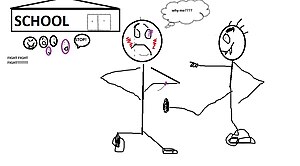| David M. Walker (U.S. Comptroller General) (Photo credit: Wikipedia) |
After we finished this series, the Government Accountability Office issued a report on school bullying that was loaded with information. You should take a look at it. Here are some additional items from the report.
Bullying at school is pervasive. After reviewing the research on school bullying, the report notes that between 20 an 28percent of student report that they have been bullied. That number is way high!
Bullying is costly. Among the results of peer bullying are the following: suicide; violent actions against others; depression; loneliness; low self-esteem; anxiety and higher risk for physical health consequences; and increased behavioral issues.
From a special education law perspective, the report notes significantly that the literature finds that victims of bullying often have academic difficulties.
49 states had bullying statutes at the time of the report, but the protections, and even the definition of bullying, varied widely from state to state.
The GAO applauds some of the collaborative efforts of the Department of Education and other federal agencies, such as the joint website Stop Bullying. But the GAO felt that the agencies could coordinate their efforts better and develop an assessment of the protections afforded by the various state civil rights laws.
Here is a summary of the GAO report.
You can read the entire 64 page GAO report here.
































